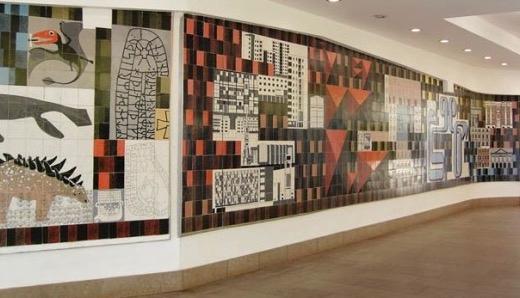Cullen Tiles

Gordon Cullen Tile Mural
At the bottom end of the Lower Precinct, just inside the doors, is a ceramic tile mural by Gordon Cullen. The mural was commissioned in 1957 by the City Planning & Redevelopment Committee on the recommendation of Arthur Ling, City Architect to the corporation, to illustrate the spirit in which the reconstruction of Coventry was being undertaken. It was made by Carter’s of Poole.

Thomas Gordon Cullen (1914-1994) was an influential Architect and urban designer who was a key motivator in the ‘Townscape movement’. He is best known for the book Townscape, first published in 1961. Cullen was born in Calverley, Pudsey, near Leeds. He studied architecture at the Royal Polytechnic Institution, the present day University of Westminste. He subsequently worked as a draughtsman in various architects’ offices, including that of Berthold Lubetkin and Tecton, but he never qualified or practised as an architect, although in 1972 he was elected as Honorary Fellow of the RIBA.
This ceramic mural was done in 1958 and depicted the history of the City and its post-war regeneration. The images on the mural are very varied ranging from dinosaurs thought to watch, cycle and car manufacturing. The mural also has elevational views of buildings in Coventry, especially the new post war buildings such as the Belgade Theatre, Hotel Leofric and Broadgate House. The design also includes Sir Basil Spence’s design for the old and new Cathedral and the churches St. John the divine for Willenhall, St. Oswald’s in Tile Hill and St. Chad’s in Wood End.
The Cullen tiles sculpture was not always in this location. It was restored and relocated from the top end of the Lower Precinct in 2002.

The original location of the Cullen mural in the Lower Precinct
Not all the original tiles survived. Some were actually destroyed before the mural was moved! The photographs below show two of the now missing elements. The first is the side of the ramp leading to the lower part of the Lower Precinct. It showed a medieval map of Coventry – the ‘1610 The Ground Plott of Coventre’ by John Speed – the earliest actual map of Coventry.
The other photograph has images which show Henry VI (left) Margaret of Anjou, John Talbot and below him Cardinal Beaufort. The design is taken from the tapestry in St. Mary’s Guildhall. It also appears to have bowmen from the Bayeux Tapestry.
It also shows various coins. Some are 17th century trade token used by shop keepers and pubs and there is also a Coventry Halfpenny. These usually date to 1669; it has an elephant and castle on it and CC either side. This is believed to be “Civitas Coventre” as with medieval coins and the elephant resembles strongly the one on the back of the chair in the council chamber in the St. Mary’s Guildhall. The trade tokens normally have the names of pubs and shopkeeper on them and symbols of their trade.
Our thanks to historian David McGrory for this information.


